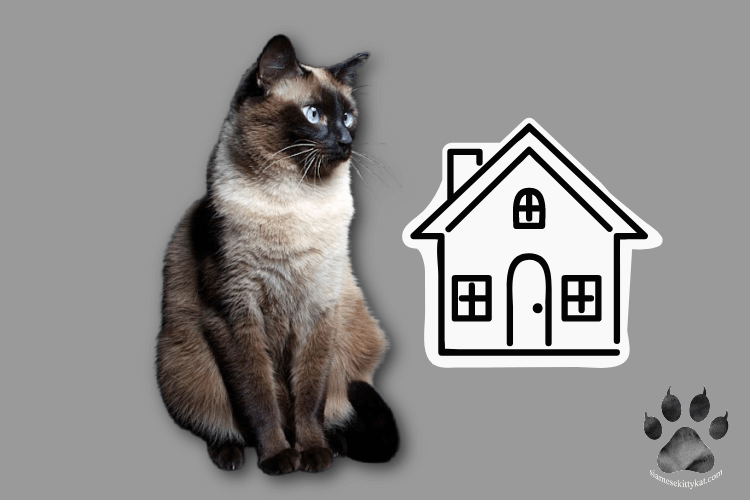Congratulations on your decision to move to a new home! Exciting times are ahead for you. Yet, let’s not forget about the challenges that come with it – particularly for your beloved Siamese cats.
Siamese cats are sensitive, and changing environments are a source of stress for them.
But don’t worry, I’m here to help you out. I’ve created this complete guide to moving to a new home with your Siamese cat.
Keep on reading!
Do Siamese Cats Get Sad When They Go To A New Home?
Yes, they do! Siamese cats are known for their strong bonds with their owners and love of routine. They feel safe and comfortable when surrounded by familiar things and routines. So, it is unsettling for them when they are taken to a new environment.
Moving to a new home is a significant change for our furry friends, and my Siamese cat Robyn is no exception. She was nervous when I first brought her to our current house. She spent most of her first day hiding under the bed.
I knew it was important to give Robyn time and space to adjust. I provided reassurance by talking soothingly to her and petting or brushing her. However, I also made sure not to push too hard. Every animal is different in how they approach change after all!
I noticed that Robyn gradually started coming out of her shell more often in the following days. She would play with toys and even seek me out on the couch for cuddles.
But then there were still moments when Robyn seemed sad, like late at night. I try to incorporate more playtime activities into Robyn’s daily routine.
These include interactive puzzles and feather teaser toys. Anything that might keep her mind and body active throughout the day!
And it worked! Robyn grew more confident in our new house over time.
How Do I Prepare My Siamese Cat to Move to a New Home?

Here are my top tips for getting your Siamese cat ready to move:
- Get your Siamese cat used to their carrier. This simple step will help them feel more comfortable and secure during travel.
Make sure you choose a sturdy, well-ventilated carrier and the right size for your cat. It can make your cat feel stressed if the carrier is too small or uncomfortable.
- Leave the carrier open in a common area of your home. You can even place a blanket or bed inside the carrier to make it extra inviting.
Let your cat explore the carrier on their own terms, and never force them inside. Treats and toys are also helpful in creating a positive association with the carrier.
- Gradually introduce your Siamese cat to short car rides. This helps them become more accustomed to the movement and sounds of a vehicle. Begin with short trips around the block and gradually lengthen the duration of your trip.
Always remember to secure the carrier safely in the car and use a seatbelt to prevent accidents.
- Schedule a visit with your veterinarian. Your vet knows your Siamese cat well. They can provide recommendations based on their needs. They may even prescribe medication to reduce anxiety or motion sickness during travel.
- Make sure your cat is up-to-date on all their vaccinations. Knowing your cat is healthy and ready for the move gives you peace of mind.
Additionally, consider obtaining a copy of your cat’s medical records to take to your new home. This will help your new vet understand your cat’s health history and medications in case of an emergency.
How Long Will it Take My Siamese Cat to Adjust to a New Home?
It takes Siamese cats from a few days to weeks to adjust fully to a new home.
You may see common behaviors during this time that indicates your cat is still adapting to its new home.
For example, you might notice your cat hiding in small spaces like under the bed or in a closet. Cats need a safe and quiet place to
retreat when they feel overwhelmed by unfamiliar surroundings.
You may also see a temporary loss of appetite due to stress. Additionally, some Siamese might become more vocal than usual. This is their way of expressing their discomfort or anxiety.
Litter box issues can also arise during your cat’s adjustment period. Try to make their litter box as inviting as possible. You can use a familiar type of litter and keep it in a quiet and accessible location.
Don’t hesitate to speak to your vet if your Siamese cat takes an unusually long time to adjust. They can provide tips and support to help your furry friend feel at home in their new environment.
How Do I Make My Siamese Cat Comfortable in a New Home?

1. Bring familiar items from your old home to your new home
Pack some of your cat’s favorite toys, bedding, and even furniture they love to snuggle up on. These familiar scents help them feel more confident in their new environment.
Avoid washing their belongings before the move. I know they smell a little funky, but these scents are part of what makes them feel at home.
2. Set up a safe space for your Siamese cat
Choose a quiet and secluded room free from potential hazards or distractions. A spare bedroom, bathroom, or walk-in closet could do the trick. Steer clear of high-traffic areas or loud appliances that cause stress for your cat.
Add some feline-friendly features to this space. Ensure they can access fresh water, a litter box, and cozy bedding. You can even add some toys or scratching posts to keep them entertained.
Ensure the temperature is comfortable for your cat and there’s adequate ventilation.
3. Provide hiding places for your Siamese cat
You can incorporate cat trees and shelves into their living space. These provide hiding places and a way for your cats to survey their
surroundings from a higher vantage point.
Another way to provide hiding places for your cat is to create small, cozy nooks around your home. You can use cardboard boxes, blankets, or repurpose furniture to create enclosed spaces.
Get creative with your cat’s hiding places! The possibilities are endless as long as it’s safe, and your cat can climb in and out.
4. Maintain a routine for your cats
Stick to your cat’s regular feeding schedule. Try to feed them at the same time every day and provide them with familiar food and water bowls. Consider setting up their feeding area in a quiet and secluded spot, so they can eat peacefully.
Another great way to keep your Siamese cat’s routine is to maintain their play schedule. Keeping your Siamese cat active helps reduce anxiety and stress as they adjust to their new home. So, don’t forget to set aside some playtime and use their favorite toys.
5. Using pheromone sprays or diffusers
These products mimic the natural pheromones released in cats’ facial glands. They’re often used to reduce stress related to separation anxiety or fear of loud noises. But they can also be helpful to use when introducing your cat to a new home.
Follow the instructions carefully when using pheromone sprays or diffusers. They should be placed in areas where your cat spends most of their time, like their cat tree or bed.
Note that these products should not be the only strategy to help your Siamese cat adjust. They won’t work miracles if your cat is not
getting enough exercise, playtime, and socialization.
6. Provide plenty of vertical space
Investing in a cat tree is one of the best ways to do this. Look for a cat tree with multiple levels and platforms. Your cat will have many options to explore and play on this way.
You can also install shelves or bookcases that your cat can use as a jungle gym. You can even create a designated climbing wall.
Don’t forget about window perches! You can install a simple bed or cushion on a windowsill, giving your cat a comfortable spot to watch the world go by. This is especially handy if your Siamese cat loves to watch birds.
7. Use positive reinforcement to help your Siamese cat settle in
Remember to praise your cat when they show good behavior. Cats respond well to positive reinforcement. It helps them understand they are doing something right.
For instance, give them a pat and say, “Good job!” if you notice your cat using their litter box or scratching their new scratching post. A little praise goes a long way.
Another way to reinforce your cat’s good behavior is by offering treats. Treats are the purrfect way to express appreciation for your cat’s good behavior. However, make sure you are giving them healthy treats for cats.
8. Using calming music or sounds
What kind of music or sounds should you play?
I recommend choosing something peaceful and relaxing, like classical music or nature sounds. You can even try playing white noise, as it helps calm cats by masking other noises that stress them out.
Keep the volume low to moderate when using music or sounds. You don’t want it to be too loud, as it can be overwhelming for your cat. Ensure the music or sounds are audible but not too close to your cat’s ears, as they have sensitive hearing.
9. Let your Siamese cat explore at their own pace
Think about it – if you were in a new and unfamiliar place, you’d want to take your time to get to know your surroundings. The same goes for your Siamese cat.
Don’t rush them to explore or force them to interact with new people or pets. This makes them feel anxious and stressed, which is not what we want for our feline friends.
Instead, let your Siamese cat be in charge of their exploration. Give them the time and space to sniff and investigate every nook and cranny.
Also, ensure all hazards, such as electrical cords or toxic plants, are out of reach. You don’t want your cat to get hurt or ingest something dangerous while exploring the new home.
Thanks for reading! I hope this guide has been helpful! Take a look at my other articles too. I’m constantly covering exciting topics related to Siamese cats.
All the best on your furry journey with Siamese cats!
We gathered all the health tips tailored toward maintaining your Siamese cat’s optimal well-being. Check it out here: Siamese Cat Health: A Complete Guide
